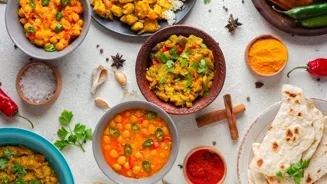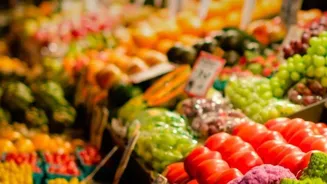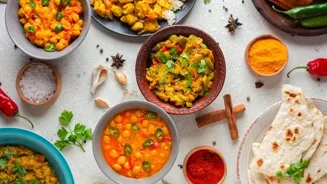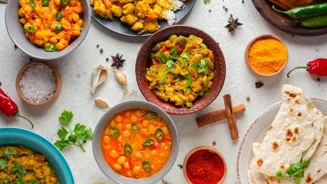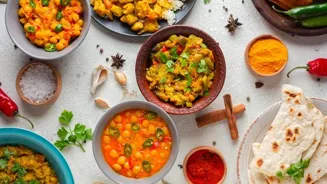Embark on a culinary adventure through India's iconic vegetarian dishes! Discover the regional stories behind 10 flavorful delights
Celebrating 10 Iconic Vegetarian Indian Dishes and Their Regional Stories
India's diverse culinary heritage explored through iconic vegetarian dishes
India, a land of vibrant colours, diverse cultures, and a history as rich as its spices, boasts a culinary heritage that's just as captivating.
From the snow-capped Himalayas to the sunny beaches of the south, each region has contributed its unique flavours and cooking styles to create a tapestry of dishes that tantalize the taste buds and nourish the soul.
This article takes you on a delicious journey across India, exploring the origins and stories behind ten iconic vegetarian dishes that have become staples in households across the subcontinent and beyond. So, get ready to embark on a foodie adventure without even leaving your seat!
We'll uncover the secrets behind these culinary gems, revealing the ingredients, techniques, and cultural influences that have shaped them into the beloved dishes we know today. Prepare to be amazed by the sheer variety and ingenuity of Indian vegetarian cuisine!
A journey into Punjabi cuisine with the decadent Dal Makhani dish
Our culinary journey begins in the northern state of Punjab, the land of five rivers and the home of Dal Makhani. This creamy and luxurious lentil dish is a testament to slow-cooking and patience.
Black lentils (urad dal) and kidney beans are simmered overnight with butter and cream, infused with ginger, garlic, and a blend of aromatic spices. The result is a rich and flavourful dish that's often served with naan or rice.
While the exact origins are debated, it is widely believed that Dal Makhani was popularized in Delhi during the partition era, evolving from a simpler lentil preparation into the decadent dish we love.
Its creamy texture and comforting flavours have made it a restaurant staple and a favourite for special occasions. The dish embodies the spirit of Punjabi cuisine – hearty, rich, and satisfying. The slow cooking process allows the flavours to meld together, creating a depth that is unparalleled.
This demonstrates how simple ingredients can transform into something truly special through skillful preparation and time.
Exploring Aloo Posto, a Bengali delicacy showcasing simplicity and flavor
Next, we head east to West Bengal, the land of sweets and the birthplace of Aloo Posto. This simple yet elegant dish features potatoes cooked in a fragrant poppy seed paste.
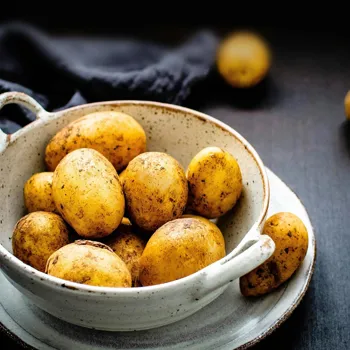
Poppy seeds (posto), a key ingredient in Bengali cuisine, are ground into a smooth paste and then simmered with diced potatoes, green chillies, and a touch of turmeric. The dish is light, subtle, and incredibly flavourful, showcasing the Bengali talent for elevating simple ingredients.
Aloo Posto is a testament to the resourcefulness of Bengali cooks, who have long used poppy seeds to add flavour and texture to their dishes. The poppy seeds impart a nutty and slightly sweet flavour to the potatoes, creating a unique and comforting dish.
It's often served with rice and is a popular choice for everyday meals. The dish reflects the importance of simple ingredients and innovative techniques in Bengali cooking, showcasing its ability to create delightful flavours.
Origin and evolution of Sambar, a South Indian staple stew
Our journey then takes us down south to Tamil Nadu, the land of temples and the origin of Sambar. This tangy and flavourful lentil-based vegetable stew is a staple of South Indian cuisine and is enjoyed across the country.
Sambar is a versatile dish that can be made with a variety of vegetables, including drumsticks, okra, pumpkin, and tomatoes. Tamarind pulp provides the characteristic tang, while sambar powder, a blend of roasted spices, adds depth and complexity.
It's usually served with rice, idli, dosa, or vada and is a comforting and nutritious meal. Sambar's origins can be traced back to the 17th century, when a Maratha ruler named Sambhaji is said to have accidentally created the dish while trying to make a lentil dish similar to dal.
Historians confirm that the dish has gone through changes over the centuries to be what it is today.
Gujarat's iconic dish Dhokla: light, fluffy, tangy, and popular street food
From Tamil Nadu, we travel to Gujarat, the land of vibrant textiles and the home of Dhokla. This steamed and fermented cake made from gram flour (besan) is a popular snack and breakfast item. Dhokla is light, fluffy, and slightly tangy, thanks to the fermentation process.
It's often seasoned with mustard seeds, green chillies, and coriander leaves and is served with a sweet and tangy chutney. Dhokla's origins lie in the Gujarati tradition of fermenting food, a technique used to enhance flavour and nutritional value.
It's a popular street food item and is also often made at home. The fermentation process adds a unique tang to the dhokla, while the steaming method ensures that it remains light and fluffy.
This dish showcases the ingenuity of Gujarati cuisine, which uses simple ingredients to create flavorful and satisfying snacks.
Traditional Rajasthani dish Dal Baati Churma: lentils, baked wheat balls, sweetened wheat
We then move to Rajasthan, the land of kings and the birthplace of Dal Baati Churma. This hearty and traditional Rajasthani dish consists of three parts: dal (lentils), baati (baked wheat balls), and churma (sweetened and crushed wheat).
Baati are hard, unleavened bread balls that are baked in a traditional oven or over charcoal. They are then dipped in ghee and served with dal and churma. Dal Baati Churma is a flavourful and filling meal that is especially popular during festivals and special occasions.
The dal is a simple lentil preparation seasoned with spices, while the churma is a sweet and crumbly mixture made from wheat flour, jaggery, and ghee. Dal Baati Churma reflects the traditions of Rajasthan, where food needs to be both filling and flavorful.
Culinary journey in Maharashtra: Pav Bhaji's iconic origins in Mumbai
Finally, we end our culinary journey in Maharashtra, the land of warriors and the origin of Pav Bhaji. This popular street food consists of a spicy vegetable mash (bhaji) served with soft bread rolls (pav).
The bhaji is made with a variety of vegetables, including potatoes, peas, cauliflower, and carrots, cooked in a tomato-based gravy with a blend of spices. Pav is lightly buttered and toasted before serving.
Pav Bhaji emerged in the bustling textile mills of Mumbai in the mid-19th century as a quick and affordable meal for workers. Vendors would gather leftover vegetables and cook them together to create a flavourful and satisfying dish that could be served with bread.
Pav Bhaji is a testament to the resourcefulness of Mumbai's street food vendors, who created a delicious and iconic dish from humble beginnings. The dish reflects the fast-paced lifestyle of urban India, where quick and satisfying meals are appreciated.
Each dish showcases India's rich culinary heritage.
AI Generated Content. Glance/InMobi shall have no liability for the content